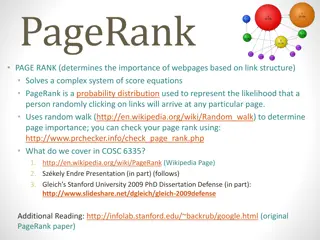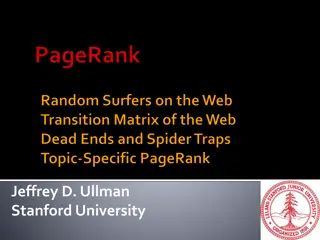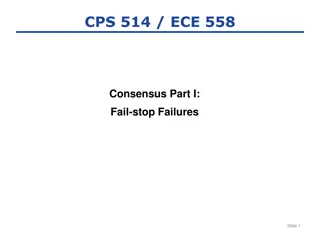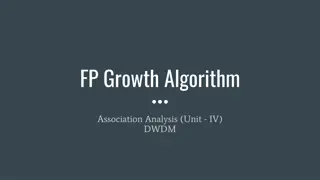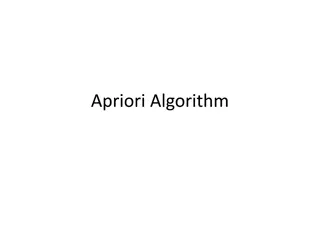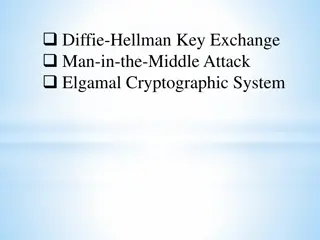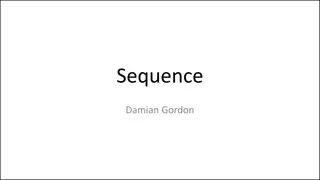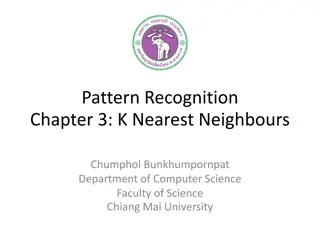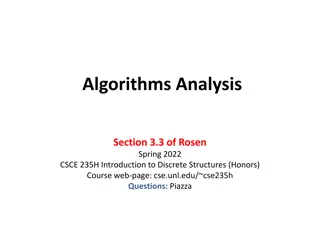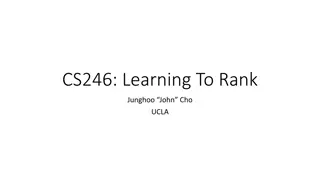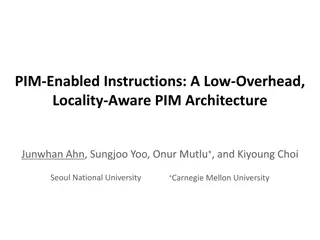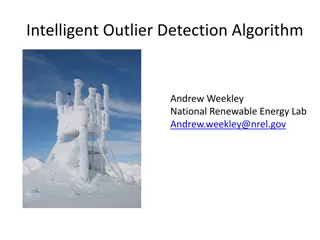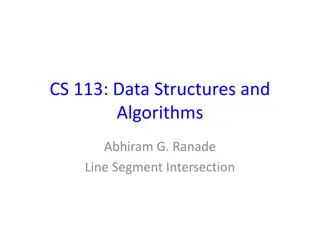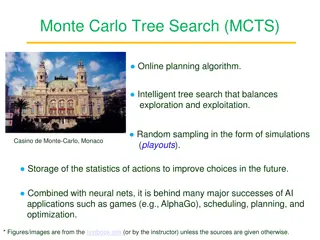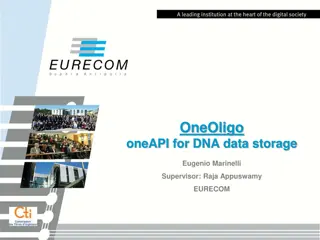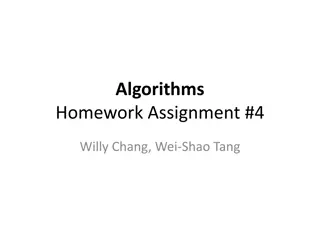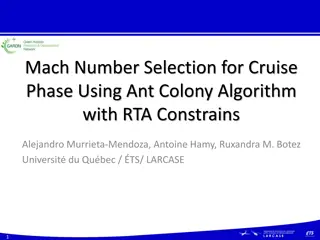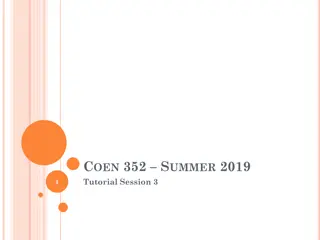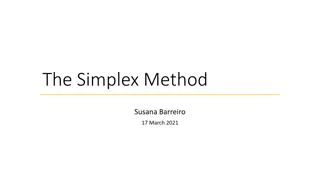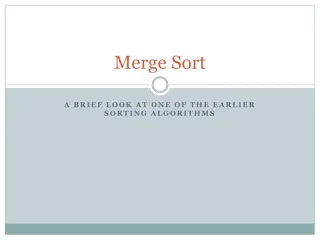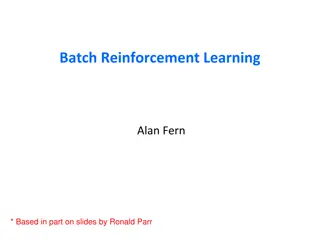Understanding PageRank Algorithm: A Comprehensive Overview
The PageRank algorithm plays a crucial role in determining the importance of web pages based on link structures. Jeffrey D. Ullman from Stanford University explains the concept of PageRank using random surfer model and recursive equations, emphasizing the principal eigenvector of the transition matrix of the web. The stochastic matrix, surfer probabilities, and long-term distribution are discussed to showcase the significance of PageRank in web search algorithms.
Uploaded on Sep 12, 2024 | 0 Views
Download Presentation

Please find below an Image/Link to download the presentation.
The content on the website is provided AS IS for your information and personal use only. It may not be sold, licensed, or shared on other websites without obtaining consent from the author. Download presentation by click this link. If you encounter any issues during the download, it is possible that the publisher has removed the file from their server.
E N D
Presentation Transcript
Jeffrey D. Ullman Stanford University
Web pages are important if people visit them a lot. But we can t watch everybody using the Web. A good surrogate for visiting pages is to assume people follow links randomly. Leads to random surfer model: Start at a random page and follow random out-links repeatedly, from whatever page you are at. PageRank = limiting probability of being at a page. 2
Solve the recursive equations: importance of a page = its share of the importance of each of its predecessor pages. Equivalent to the random-surfer definition of PageRank. Technically, importance = the principal eigenvector of the transition matrix of the Web. A few fixups needed. 3
Number the pages 1, 2, . Page i corresponds to row and column i. M [i, j] = 1/n if page j links to n pages, including page i ; 0 if j does not link to i. M [i, j] is the probability a surfer will next be at page i if it is now at page j. Or it is the share of j s importance that i receives. 4
Suppose page j links to 3 pages, including i but not x. j i 1/3 x 0 Called a stochastic matrix = all columns sum to 1. 5
Suppose v is a vector whose ith component is the probability that a random surfer is at page i at a certain time. If a surfer chooses a successor page from page i at random, the probability distribution for surfers is then given by the vector Mv. 6
Starting from any vector u, the limit M (M ( M (M u) )) is the long-term distribution of the surfers. The math: limiting distribution = principal eigenvector of M = PageRank. Note: If vis the limit of MM Mu, then v satisfies the equation v = Mv, so v is an eigenvector of M with eigenvalue 1. 7
y a m Yahoo y 1/2 1/2 0 a 1/2 0 1 m 0 1/2 0 Amazon M soft 8
Because there are no constant terms, the equations v = Mv do not have a unique solution. Example: doubling each component of solution v yields another solution. In Web-sized examples, we cannot solve by Gaussian elimination anyway; we need to use relaxation (= iterative solution). 9
Start with the vector u= [1, 1,, 1] representing the idea that each Web page is given one unit of importance. Note: it is more common to start with each vector element = 1/N, where N is the number of Web pages and to keep the sum of the elements at 1. Question for thought: Why such small values? Repeatedly apply the matrix M to u, allowing the importance to flow like a random walk. About 50 iterations is sufficient to estimate the limiting solution. 10
Equations v= Mv: y = y /2 + a /2 a = y /2 + m m = a /2 Note: = is really assignment. y a = m 1 1 1 1 3/2 1/2 5/4 1 3/4 9/8 11/8 1/2 6/5 6/5 3/5 . . . 11
Yahoo Amazon M soft 12
Yahoo Amazon M soft 13
Yahoo Amazon M soft 14
Yahoo Amazon M soft 15
Yahoo Amazon M soft 16
Some pages are dead ends (have no links out). Such a page causes importance to leak out, or surfers to disappear. Other groups of pages are spider traps (all out- links are within the group). Eventually spider traps absorb all importance; all surfers get stuck in the trap. 18
y a m Yahoo y 1/2 1/2 0 a 1/2 0 0 m 0 1/2 0 Amazon M soft A substochastic matrix = all columns sum to at most 1. 19
Equations v= Mv: y = y /2 + a /2 a = y /2 m = a /2 y a = m 1 1 1 1 1/2 1/2 3/4 1/2 1/4 5/8 3/8 1/4 0 0 0 . . . 20
Yahoo Amazon M soft 21
Yahoo Amazon M soft 22
Yahoo Amazon M soft 23
Yahoo Amazon M soft 24
Yahoo Amazon M soft 25
y a m Yahoo y 1/2 1/2 0 a 1/2 0 0 m 0 1/2 1 Amazon M soft 26
Equations v= Mv: y = y /2 + a /2 a = y /2 m = a /2 + m y a = m 1 1 1 1 1/2 3/2 3/4 1/2 7/4 5/8 3/8 2 0 0 3 . . . 27
Yahoo Amazon M soft 28
Yahoo Amazon M soft 29
Yahoo Amazon M soft 30
Yahoo Amazon M soft 31
Tax each page a fixed percentage at each iteration. Add a fixed constant to all pages. Optional but useful: add exactly enough to balance the loss (tax + PageRank of dead ends). Models a random walk with a fixed probability of leaving the system, and a fixed number of new surfers injected into the system at each step. Divided equally among all pages. 32
Equations v = 0.8(Mv) + 0.2: y = 0.8(y/2 + a/2) + 0.2 a = 0.8(y/2) + 0.2 m = 0.8(a/2 + m) + 0.2 Note: amount injected is chosen to balance the tax. If we started with 1/3 for each rather than 1, the 0.2 would be replaced by 0.0667. y a = m 1 1 1 1.00 0.60 1.40 0.84 0.60 1.56 0.776 0.536 1.688 7/11 5/11 21/11 . . . 33
Goal: Evaluate Web pages not just by popularity, but also by relevance to a particular topic, e.g. sports or history. Allows search queries to be answered based on interests of the user. Example: Search query [jaguar] wants different pages depending on whether you are interested in automobiles, nature, or sports. Might discover interests by browsing history, bookmarks, e.g. 35
Assume each surfer has a small probability of teleporting at any tick. Teleport can go to: 1. Any page with equal probability. As in the taxation scheme. 2. A set of relevant pages (teleport set). For topic-specific PageRank. Note: can also inject surfers to compensate for surfers lost at dead ends. Or imagine a surfer always teleports from a dead end. 36
Only Microsoft is in the teleport set. Assume 20% tax. I.e., probability of a teleport is 20%. 37
Yahoo Dr. Who s phone booth. Amazon M soft 38
Yahoo Amazon M soft 39
Yahoo Amazon M soft 40
Yahoo Amazon M soft 41
Yahoo Amazon M soft 42
Yahoo Amazon M soft 43
Yahoo Amazon M soft 44
1. One option is to choose the pages belonging to the topic in Open Directory. 2. Another option is to learn, from a training set (which could be Open Directory), the typical words in pages belonging to the topic; use pages heavy in those words as the teleport set. 45
Spam farmers create networks of millions of pages designed to focus PageRank on a few undeserving pages. We ll discuss this technology shortly. To minimize their influence, use a teleport set consisting of trusted pages only. Example: home pages of universities. 46
Mutually recursive definition: A hub links to many authorities; An authority is linked to by many hubs. Authorities turn out to be places where information can be found. Example: course home pages. Hubs tell where the authorities are. Example: departmental course-listing page. 48
HITS uses a matrix A[i, j] = 1 if page i links to page j, 0 if not. AT, the transpose of A, is similar to the PageRank matrix M, but AThas 1 s where M has fractions. Also, HITS uses column vectors h and a representing the degrees to which each page is a hub or authority, respectively. Computation of h and a is similar to the iterative way we compute PageRank. 49
y a m Yahoo y 1 1 1 a 1 0 1 m 0 1 0 A = Amazon M soft 50


